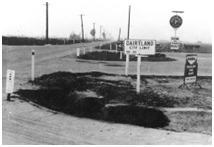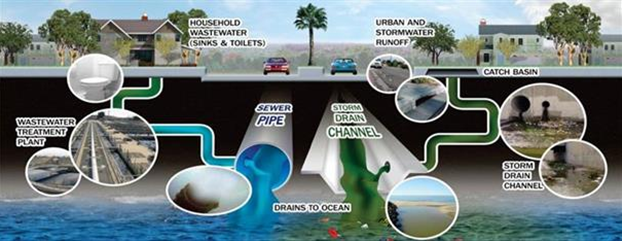HISTORY OF THE CITY OF LA PALMA
With 18 dairies dotting an area of 1.76 square miles, the City of La Palma in 1955 looked nothing like it does today. In fact, the City of La Palma was first incorporated as Dairyland and remained so until the dairies relocated.
The name was changed in 1965 to La Palma in a reflection of Orange County’s Spanish heritage and the City’s main street, La Palma Avenue. Soon after the small farming community began its life, City planners decided that the City should benefit from a long-term program for orderly development.
The Civic Center and Central Park, now La Palma’s premier gathering places, were among the first projects to be completed to better the community. The City’s major redevelopment project, Centerpointe, added new commercial and light industrial uses in the early 1980s.

La Palma is a well-balanced city that prides itself on a responsive municipal government and a strong sense of community. The City’s small-town character allows residents to live in quiet and friendly neighborhoods. With one of the lowest crime rates in Orange County, La Palma is a place where residents can rest easy and enjoy hometown living. The City has been ranked one of America’s Best Places to Live, by Money Magazine in 2007, 2011, 2013, and 2015.
WHERE DOES LA PALMA CITY WATER COME FROM?
Orange County’s water supplies are a blend of groundwater managed by the Orange County Water District (OCWD) and water imported from Northern California and the Colorado River by the Municipal Water District of Orange County (MWDOC) via Metropolitan Water District of Southern California (MWDSC). Groundwater comes from a natural underground aquifer that is replenished with water from the Santa Ana River, local rainfall, and imported water. The groundwater basin is 350 square miles and lies beneath north and central Orange County from Irvine to the Los Angeles County border and from Yorba Linda to the Pacific Ocean. More than 20 cities and retail water districts draw from the basin to provide water to homes and businesses.
ARE THERE CONTAMINANTS IN LA PALMA CITY WATER?
The sources of drinking water (both tap water and bottled water) include rivers, lakes, streams, ponds, reservoirs, springs and wells. As water travels over the
the surface of the land or through the layers of the ground it dissolves naturally-occurring minerals and, in some cases, radioactive material, and can pick up substances resulting from the presence of animal and human activity.
Contaminants that may be present in source water include:
Pesticides and herbicides, which may come from a variety of sources such as agriculture, urban stormwater runoff and residential uses.
Microbial contaminants, such as viruses and bacteria, which may come from sewage treatment
plants, septic systems, agricultural livestock operations and wildlife.
Radioactive contaminants, which can be naturally occurring or be the result of oil and gas production or mining activities.
Inorganic contaminants, such as salts and metals, which can be naturally occurring or result from urban storm runoff, industrial or domestic wastewater discharges, oil and gas production, mining and farming.
Organic chemical contaminants, including synthetic and volatile organic chemicals, which are by-products of industrial processes and petroleum production, and can also come from gasoline stations, urban stormwater runoff, agricultural application and septic systems
SHOULD I DRINK AND BATHE WITH LA PALMA CITY WATER STRAIGHT FROM MY FAUCET?
Some people may be more vulnerable to contaminants in drinking water than the general population. Immuno-compromised people, such as those with cancer who are undergoing chemotherapy, persons who have had organ transplants, people with HIV/AIDS or other immune system disorders, some elderly persons and infants can be particularly at risk from infections. These people should seek advice about drinking water from their health care providers.
The USEPA and the federal Centers for Disease Control guidelines on appropriate means to lessen the risk of infection by Cryptosporidium and other microbial contaminants are available from USEPA’s Safe Drinking Water Hotline at (800) 426-4791 between 10 a.m. and 4 p.m. Eastern Time (7 a.m. to 1 p.m. in California)- source: 2017La Palma Water consumer confidence report.
https://www.cityoflapalma.org/DocumentCenter/View/7925/La-Palma-2018-WQR?bidId=
Complete Plumbing recommends installing a Catalytic Carbon Whole house water filtration system by Aqualistic Water Products to remove most of the harmful chemicals in your city water, leaving you with bottled quality water at every faucet in your home.
LA PALMA PLUMBING TIPS
Fix leaky faucets. For every leak stopped, you can save 20 gallons of water per day.
Develop a watering schedule for your irrigation system. To learn more, visit www.bewaterwise.com/calculator.html.
Use native plants in your landscaping. Planting and maintaining beautiful California native and water-friendly plants can save between 1,000 and 1,800 gallons per month.
Install a high-efficiency toilet or clothes washer. A temporary rebate program is still available. Other rebates are also available for sprinklers and artificial turf. To learn more, visitwww.ocwatersmart.com.
MWDSC has its own water conservation website. To find out more information on water-saving plants and other useful tips, visit www.bewaterwise.com.
LA PALMA RESIDENTS should make sure that their plumbing systems are in good working order and are leak-free. This is important, not only for saving money on your water bill and limiting damages to property, but it is our responsibility to provide clean fresh water for future generations.
DID YOU KNOW?
Water Leaks:
- Nationwide, more than 1 trillion gallons of water are lost annually due to household leaks. That’s equal to the annual water use of more than 11 million homes.
- The average household can waste more than 10,000 gallons each year due to correctable leaks. That’s enough to wash 270 loads of laundry!
- Ten percent of homes have leaks that waste 90 gallons or more per day! Common sources include toilets, faucets, showerheads, and landscape irrigation. But you should also consider less obvious sources of leaks: water heaters, ice makers, dishwashers, and filtration systems. Many of these are easily correctable, and fixing them can save about 10 percent on the average water bill.
- Be sure to check your toilet for leaks at least once a year. Put food coloring in the tank. If it seeps into the bowl without flushing, there’s a leak. And if your toilet flapper doesn’t close properly after flushing, replace it.
- Remember, one drip a second adds up to five gallons lost per day!
So regularly check your faucets and showerheads, as well as all hoses and connectors. - Many household leaks can be solved with simple tools and a little education — and fortunately, Do-It-Yourselfers have access to multiple resources. But even if you must pay for repairs, you will still save money in the long run. For more information on water conservation, visit ocwatersmart.com.
- Complete plumbing provides leak detection of even the smallest amount of water which could prevent costly water bills and possible damage due to water leaks
- Complete plumbing utilizes automatic water shut off valves that detect leaks, automatically shuts off the water to your home then sends you an alert via a smartphone app. You can turn the water on and off, monitor water usage and temperature right from your phone!
LA PALMA CITY SEWER DRAINAGE SYSTEM
Regional wastewater collection, treatment, and disposal are served by the Orange County Sanitation District by way of agreement between the two agencies. Three separate OCSD trunk sewer systems collect La Palma’s flows within Denni Street (OCSD Los Alamitos Sub-Trunk), Moody Street (OCSD West-side Relief Interceptor), and Valley View Street (OCSD Miller-Holder Trunk). These regional systems convey wastewater flows from several north Orange County municipal sewer systems to OCSD’s treatment and reclamation facility in Fountain Valley.
The City’s service area ranges between approximately 35 feet to 55 feet above mean sea level, gently sloping from the northeast to the south and west. With this minimal elevation difference, City development planning has been essential to maintaining gravity flow conditions throughout the collection system. The City’s sewer system serves over 4,000 connections with approximately 30 miles of gravity sewers and over 700 manholes

- Most La Palma homes have just one main sewer pipe that connects the sewer system from their house to the city’s main sewer system. Homeowners are required to maintain that sewer pipe up to and including the middle of the street and may be responsible for repair costs should a problem occur.
- Complete Plumbing can use a sewer drain camera and location device to inspect sewer lines for breaks, cracks root intrusions. This simple examination of your sewer system may save thousands of dollars in repair costs.
What is Storm Water Pollution?

Stormwater is water from rain that does not soak into the ground. It flows over paved areas like streets, sidewalks, and parking lots, as well as roofs and sloped lawns. As it flows, the stormwater collects and carries pollutants such as litter, pet waste, pesticides, fertilizers, and motor oil. This “toxic soup” then flows through a massive system of pipes and channels directly into our local waterways and the ocean.
What is the difference between the storm drain system and the sanitary sewer system?
The storm drain system and sanitary sewer system are both large conveyance systems of underground pipes. This leads to the misconception that the systems are one and the same. They are in fact separated and serve different purposes.
The sanitary sewer system transports domestic sewage to a treatment plant. Domestic sewage includes wastewater from household and commercial plumbing, such as toilets, showers, and sinks. There, contaminants are removed from the sewage through a multi-stage process, which includes settling, filtering, and biological and chemical treatment. The treated water is then discharged into local waterways or used as reclaimed water.
The storm drain system, on the other hand, was designed to prevent cities from flooding. Its purpose is to quickly transport rain runoff (stormwater) away from the city and into the nearest waterway, without treatment. And so, any pollution carried by stormwater also enters our waterways untreated.

We have been serving La Palma Residents for over 30 years and know a lot about La Palma water filtration systems, La Palma Plumbing Systems, La Palma heating, and air conditioning systems, La Palma tankless water heaters, La Palma drain cleaning
Call and ask about our La Palma residents specials
READY TO GET STARTED?